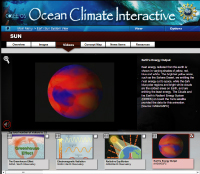Since the initiation of state and national science standards and application of high stakes accountability testing, research has shown educators have focused more on the factual parts of science, often neglecting the concepts of science and – in many cases – the context of science. As stated by Munby et. al. (2000): “when science is separated from its original contexts of investigations and questioning and becomes transplanted in secondary school culture, it becomes inauthentic". 1
User feedback has reinforced the desire for interactive products and processes that highlight fundamental concepts as well as their "big picture" connections. As a result, COSEE-OS is moving forward in its development of effective tools and techniques to aid learners in better understanding the context of the oceans in both the earth and solar systems. Acting upon recent national efforts to “map” ocean topics into the educational standards, we are piloting effective ways to bring the relevance of the oceans to classrooms, particularly rural and inland audiences. The outcome of this is a suite of web-based, ocean-climate multimedia known as the Concept Linked Integrated Media Builder (CLIMB), which consists of the Ocean-Climate Interactive and the Concept Map Builder.
We also offer Oceans in the News, a compilation of current news materials relevant to oceans and climate. Oceans in the News provides a clearinghouse of current, relevant headlines, highlights freely available web content, and identifies links to relevant visualizations.
Click on the links in the menu at left to learn more about our interactive media, access our tutorials, and begin using our online tools. The orange buttons below will take you directly to the tools. Click here to view an evaluation of our tools by participants at our Educator-Scientist Collaborative workshop, held at the UConn Avery Point Campus in October 2009.
1Munby, H. M., Lock, C. (2000). School Science Culture: A Case Study of Barriers to Developing Professional Knowledge, Science Education, 84(2), 193-211.
|






